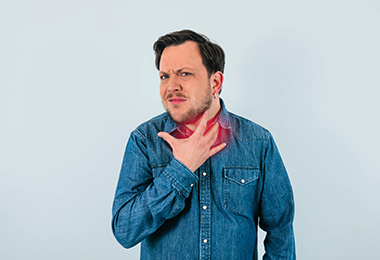Parathyroidectomy
What You Need to Know
- The four parathyroid glands, each about the size of a grain of rice, are located behind the thyroid gland in the neck.
- Hormones from the parathyroid glands regulate blood levels of calcium and other minerals. Parathyroid gland problems requiring parathyroidectomy include hyperparathyroidism, parathyroid nodules and parathyroid tumors.
- Surgeons can access the parathyroid glands through an incision at the front of the neck, or through the mouth (scarless procedure).
Why might I need a parathyroidectomy?
The parathyroid glands can develop benign (or, rarely, malignant) growths that cause over- or under-production of parathyroid hormone (PTH). Radiation therapy, nutritional deficiencies and the use of some medications such as lithium can also damage the parathyroid glands and affect their production of PTH.
An imbalance of PTH affects blood levels of calcium. Too little calcium can cause bone problems, depression, fatigue and other symptoms, while too much calcium can result in problems such as kidney stones, muscle spasms and nerve pain.
Blood tests, urinalysis, bone density screenings and imaging tests can help the doctor determine if there is a problem with your parathyroid glands that requires removal.
What are the risks of parathyroidectomy?
-
Persistent low blood calcium levels
-
Voice changes, such as hoarseness
-
Sore throat
-
Bleeding and blood clots
-
Adhesions or scar tissue requiring further surgery
-
Injury to the esophagus or trachea (windpipe)
What happens during a parathyroidectomy?
Before the Procedure
The doctor may order imaging and laboratory tests, such as:
-
Ultrasound, sestamibi nuclear medicine scan, computed tomography (CT) or magnetic resonance imaging (MRI) to visualize the parathyroid glands and surrounding areas
-
Blood test(s), urinalysis, bone density screening
-
Examination of the vocal cords and their function using an instrument called a laryngoscope
Just before your procedure, the surgical team may give you an antibiotic if you are prone to infections because of a problem with your immune system or other condition. You may receive medicines to reduce nausea and vomiting (antiemetics).
Different Types of Parathyroidectomy
Traditional Parathyroidectomy
Most parathyroidectomies take place while the person is under general anesthesia, asleep and pain-free.
The surgeon makes a small incision in the skin of the neck and parts a thin layer of muscle to gain access to the thyroid gland and the parathyroid glands behind it. The surgeon can examine the parathyroid glands and remove those that are damaged or affected by disease.
The surgeon then returns the muscles of the front of the neck to their proper position and secures them in place. The skin is closed with sutures or glue.
Thyroid and Parathyroid Care

Our thyroid specialists, as part of the head and neck endocrine surgery team, diagnose and treat patients with a variety of thyroid and parathyroid conditions, including tumors, nodules and hyperparathyroidism.
Scarless (Transoral) Parathyroidectomy
This is a newer technique for select patients that involves accessing the parathyroid glands through the mouth. This surgery leaves no visible scar since there is no incision on the outside of the neck.
Parathyroidectomy: Recovery and Next Steps
After a parathyroidectomy, you are likely to go home with some calcium supplements until the remaining normal parathyroid glands “wake up” and resume functioning.





